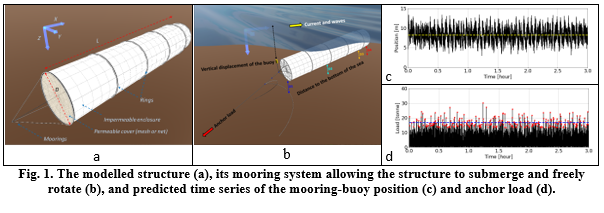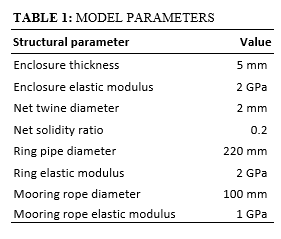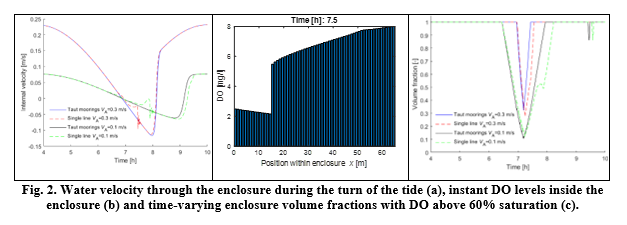NUMERICAL ANALYSIS OF NOVEL OFFSHORE AQUACULTURE SYSTEMS
Introduction
Offshore structures for finfish aquaculture must meet high standards for reliability and animal welfare. Numerical modelling can help assess alternative designs and find solutions that ensure structural reliability in challenging offshore environments. However, this alone is insufficient. For fish welfare , it is also crucial to maintain adequate space, water quality, and dissolved oxygen (DO) levels within the sea cage. Comprehensive analysis tools are needed to evaluate and optimise new aquaculture systems for their ability to withstand offshore environmental loads while promoting fish welfare. Currently, such tools are absent in both offshore engineering and traditional coastal aquaculture technology.
To address this gap, SINTEF Ocean has developed numerical techniques for modelling and integrated analysis of flexible aquaculture structures and mooring systems within the time-domain simulation framework FhSim [1]. This presentation showcases the numerical modelling of a novel membrane enclosure system for open-ocean finfish aquaculture in New Zealand [2, 3]. The focus is on the flexible structure design and mooring optimisation required to withstand offshore loads, as well as the water flow and dissolved oxygen (DO) transport necessary for fish well-being.
Simulation model
The fish enclosure was modelled as a horizontal fabric cylinder with net-covered ends, stiffened by outer ring structures to maintain its shape (Fig. 1a) . The length of the structure (L) is 65 m, and the diameter (D ) is 14 m. A single-point mooring (SPM) system allowed the structure to rotate freely with the flow while submerged below depths strongly affected by waves (Fig. 1b) . TABLE 1 summarises the main structural parameters used in the present simulations.
Results and discussions
Time-domain simulations examined the motion of the moored structure in waves and currents, modelling extreme sea states to evaluate structural and mooring reliability under design loads. Fig. 1b shows the structure in an extreme sea state (described by a JONSWAP spectrum): significant wave height Hs = 7.17 m; peak wave period Tp = 11.29 s; current speed U = 0.52 m/s. T he predict ed vertical displacements of the mooring buoy (2000-L volume ) are shown in Fig. 1c , and the corresponding anchor loads are shown in Fig. 1d. Simulations showed that the wave forces acting on the enclosure decrease with increasing submergence, while the anchor loads are also dependent on the buoy size.
The model was also used to predict the structure’s motion in a harmonic tidal current (with different velocity amplitudes VA) and the ir combined effect on the water flow through the enclosure (Fig. 2a). S lack (single-line) and taut mooring configurations were considered here. These simulations provided the basis for predicting the DO dynamics within the enclosure considering different water temperatures and fish respiration rates [3]. Since adequate DO levels are crucial for fish welfare, simulations were used to identify periods of reduced DO levels during tidal transitions (Fig. 2b-c). The internal conditions were characterise d by evaluating volume fractions with DO levels above 60% saturation, which is considered a threshold for salmon welfare. Results showed that the motion of the structure connected to an SPM system significantly impacts internal oxygen levels, offering insights for optimising the mooring design.
Conclusion
The presented case study highlights the benefits of using numerical simulations to support the development of flexible structures for offshore aquaculture. With modifications, the presented numerical framework could also be useful for modelling other aquaculture systems, including conventional net pens.
References
[1] Su, B., Reite, K.-J., Føre , M., Aarsæther , K.G., Alver, M.O., Endresen, P.C., Kristiansen, D., Haugen, J., Caharija , W., Tsarau, A., 2019. A Multipurpose Framework for Modelling and Simulation of Marine Aquaculture Systems, in: OMAE2019.
[2] Black, S. et al., 2024. Designing for the Animal: Reimagining Offshore Fish Structures. In International Conference on Offshore Mechanics and Arctic Engineering (Vol. 87875, p. V009T13A004). American Society of Mechanical Engineers.
[3] Tsarau, A. et al., 2024. Technological Feasibility Study and Fish Welfare Considerations for Novel Structures in Open Ocean Aquaculture. In International Conference on Offshore Mechanics and Arctic Engineering (Vol. 87813, p. V004T05A007).







